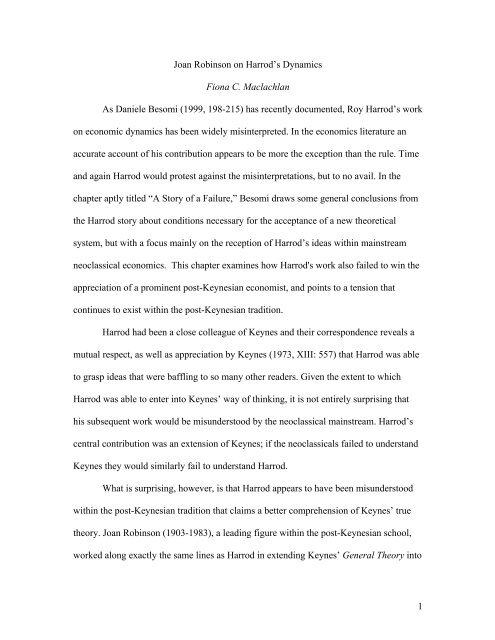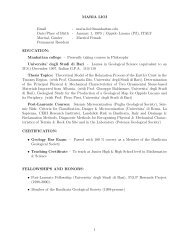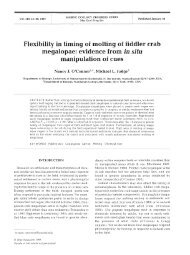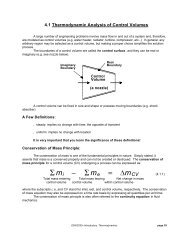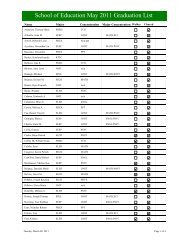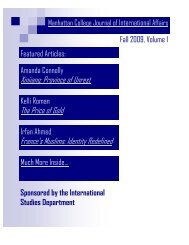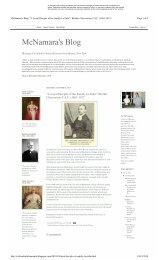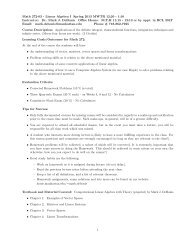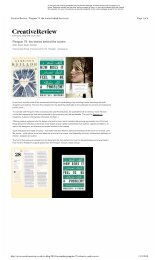1 Joan Robinson on Harrod's Dynamics Fiona C. Maclachlan As ...
1 Joan Robinson on Harrod's Dynamics Fiona C. Maclachlan As ...
1 Joan Robinson on Harrod's Dynamics Fiona C. Maclachlan As ...
Create successful ePaper yourself
Turn your PDF publications into a flip-book with our unique Google optimized e-Paper software.
<str<strong>on</strong>g>Joan</str<strong>on</strong>g> <str<strong>on</strong>g>Robins<strong>on</strong></str<strong>on</strong>g> <strong>on</strong> Harrod’s <strong>Dynamics</strong><br />
Fi<strong>on</strong>a C. <strong>Maclachlan</strong><br />
<strong>As</strong> Daniele Besomi (1999, 198-215) has recently documented, Roy Harrod’s work<br />
<strong>on</strong> ec<strong>on</strong>omic dynamics has been widely misinterpreted. In the ec<strong>on</strong>omics literature an<br />
accurate account of his c<strong>on</strong>tributi<strong>on</strong> appears to be more the excepti<strong>on</strong> than the rule. Time<br />
and again Harrod would protest against the misinterpretati<strong>on</strong>s, but to no avail. In the<br />
chapter aptly titled “A Story of a Failure,” Besomi draws some general c<strong>on</strong>clusi<strong>on</strong>s from<br />
the Harrod story about c<strong>on</strong>diti<strong>on</strong>s necessary for the acceptance of a new theoretical<br />
system, but with a focus mainly <strong>on</strong> the recepti<strong>on</strong> of Harrod’s ideas within mainstream<br />
neoclassical ec<strong>on</strong>omics. This chapter examines how <strong>Harrod's</strong> work also failed to win the<br />
appreciati<strong>on</strong> of a prominent post-Keynesian ec<strong>on</strong>omist, and points to a tensi<strong>on</strong> that<br />
c<strong>on</strong>tinues to exist within the post-Keynesian traditi<strong>on</strong>.<br />
Harrod had been a close colleague of Keynes and their corresp<strong>on</strong>dence reveals a<br />
mutual respect, as well as appreciati<strong>on</strong> by Keynes (1973, XIII: 557) that Harrod was able<br />
to grasp ideas that were baffling to so many other readers. Given the extent to which<br />
Harrod was able to enter into Keynes’ way of thinking, it is not entirely surprising that<br />
his subsequent work would be misunderstood by the neoclassical mainstream. Harrod’s<br />
central c<strong>on</strong>tributi<strong>on</strong> was an extensi<strong>on</strong> of Keynes; if the neoclassicals failed to understand<br />
Keynes they would similarly fail to understand Harrod.<br />
What is surprising, however, is that Harrod appears to have been misunderstood<br />
within the post-Keynesian traditi<strong>on</strong> that claims a better comprehensi<strong>on</strong> of Keynes’ true<br />
theory. <str<strong>on</strong>g>Joan</str<strong>on</strong>g> <str<strong>on</strong>g>Robins<strong>on</strong></str<strong>on</strong>g> (1903-1983), a leading figure within the post-Keynesian school,<br />
worked al<strong>on</strong>g exactly the same lines as Harrod in extending Keynes’ General Theory into<br />
1
the l<strong>on</strong>g period, relaxing his assumpti<strong>on</strong> of a fixed capital stock. In the preface to The<br />
Accumulati<strong>on</strong> of Capital (1956), <str<strong>on</strong>g>Robins<strong>on</strong></str<strong>on</strong>g> expresses gratitude for the inspirati<strong>on</strong> that<br />
Harrod had provided with his own work <strong>on</strong> the topic. And yet, <strong>on</strong> the next page she<br />
points to what she perceives as a serious deficiency in his work. Later in the book, she<br />
reveals her objecti<strong>on</strong> to what is arguably his most important theoretical c<strong>on</strong>tributi<strong>on</strong>—the<br />
c<strong>on</strong>cept of the warranted rate of growth (<str<strong>on</strong>g>Robins<strong>on</strong></str<strong>on</strong>g> 1956, 404-406). For Harrod’s part, he<br />
was to claim as late as 1970 that an article that <str<strong>on</strong>g>Robins<strong>on</strong></str<strong>on</strong>g> had written <strong>on</strong> his views<br />
“appears to be somewhat lacking in comprehensi<strong>on</strong> of their c<strong>on</strong>tent” (1970, 737). We<br />
cannot pin this failure to communicate <strong>on</strong> the limits of a mind infused with the<br />
neoclassical prejudices. A study of <str<strong>on</strong>g>Robins<strong>on</strong></str<strong>on</strong>g>’s reacti<strong>on</strong>s to Harrod’s ideas finds both a<br />
parallel with the mainstream reacti<strong>on</strong>, and a source of c<strong>on</strong>tinuing tensi<strong>on</strong> within the post-<br />
Keynesian traditi<strong>on</strong>.<br />
The Shadow of Keynes<br />
Both Harrod and <str<strong>on</strong>g>Robins<strong>on</strong></str<strong>on</strong>g> were involved in discussi<strong>on</strong>s with Keynes as he<br />
moved from the Treatise to the General Theory and shared a sympathetic understanding<br />
of the break he was making from the theory that came before. Both accepted that the<br />
ec<strong>on</strong>omic system was not inherently self-regulating and understood that c<strong>on</strong>sumpti<strong>on</strong><br />
spending and investment spending could move in the same directi<strong>on</strong> without the interest<br />
rate correcting the matter. But there were also important differences between them. They<br />
differed in their percepti<strong>on</strong> of the value of the traditi<strong>on</strong>al theory from which Keynes was<br />
breaking, and they differed in their judgment <strong>on</strong> how best to move forward from the base<br />
of the General Theory.<br />
2
Harrod believed there was no major inc<strong>on</strong>sistency between what Keynes was<br />
doing and the greater part of the neoclassical theory of value and distributi<strong>on</strong>. He divided<br />
ec<strong>on</strong>omic theory into four comp<strong>on</strong>ents. There was the static part and the dynamic part<br />
and then both of these had their micro and macro comp<strong>on</strong>ents. He viewed the traditi<strong>on</strong>al<br />
theory of value and distributi<strong>on</strong> as falling under microstatics, while Keynes’ theory was<br />
essentially macrostatics. There was little inc<strong>on</strong>sistency because they covered “different<br />
domains” (Harrod 1973, 2).<br />
Harrod believed, however, that some parts of Keynes should be classified under<br />
macrodynamics. Harrod (1959, 454) thought Keynes' failure to carefully distinguish<br />
between dynamics and statics, a serious flaw in the General Theory. It is the tensi<strong>on</strong><br />
between the static and dynamic comp<strong>on</strong>ent in Keynes' theory that has led to intense<br />
debates about what he really meant. Hicks’ static IS-LM model became the standard<br />
interpretati<strong>on</strong> of his theory but post-Keynesian writers, and eventually even Hicks (1981-<br />
2, 139) himself, argued that his central message was lost in this c<strong>on</strong>structi<strong>on</strong>. Today the<br />
standard wisdom is that Keynesian unemployment is due to rigid wages--another result of<br />
thinking in terms of a static general equilibrium model. Harrod (1973, 65) has remarked:<br />
“Some commentators have suggested that Keynes’ system depends <strong>on</strong> wages being<br />
flexible downwards, as indeed they usually are these days. This shows a complete lack of<br />
intellectual grasp of his system.” Had Keynes been more careful with the distincti<strong>on</strong><br />
between the static and dynamic parts of his analysis, this misinterpretati<strong>on</strong> would have<br />
been less likely.<br />
For Harrod, saving is a dynamic c<strong>on</strong>cept and cannot be fitted into a static<br />
framework. His c<strong>on</strong>tributi<strong>on</strong> to the Keynesian legacy is his fundamental equati<strong>on</strong>, which<br />
3
he describes as a dynamised versi<strong>on</strong> of the saving investment identity. In the form of<br />
warranted rate, it is “simply the dynamised versi<strong>on</strong> of Keynes’ excess or deficiency of<br />
aggregate demand in relati<strong>on</strong> to what is required for full employment” (Harrod 1959,<br />
456). Harrod thought it was <strong>on</strong>ly insofar as static models tried to incorporate saving and<br />
accumulati<strong>on</strong> that they were in error. Otherwise, he thought the broad outlines of the<br />
theory developed by the neoclassical ec<strong>on</strong>omists of the 19 th and early 20 th centuries was<br />
valuable and worth preserving (Harrod 1948, 4-5). He believed Keynes was inclined to<br />
overstate the revoluti<strong>on</strong>ary nature of his c<strong>on</strong>tributi<strong>on</strong>, remarking that “this may have d<strong>on</strong>e<br />
some harm to the progress of ec<strong>on</strong>omic theory, which should c<strong>on</strong>sist of a system of<br />
harm<strong>on</strong>ious c<strong>on</strong>cepts” (Harrod 1973, 63-4).<br />
<str<strong>on</strong>g>Robins<strong>on</strong></str<strong>on</strong>g> was more sympathetic to Keynes’ claims to having revoluti<strong>on</strong>ized<br />
ec<strong>on</strong>omic theory, and did not share Harrod’s view that his theory was essentially static.<br />
On the c<strong>on</strong>trary, <str<strong>on</strong>g>Robins<strong>on</strong></str<strong>on</strong>g> writes that Keynes “smashed up the glass house of static<br />
theory” (1956, v). She was inclined to believe that traditi<strong>on</strong>al ec<strong>on</strong>omic theory was not<br />
much more than apologia for laissez faire capitalism and as such, worth discarding. For<br />
<str<strong>on</strong>g>Robins<strong>on</strong></str<strong>on</strong>g>, the theories of Kalecki and Sraffa held much more promise in explaining<br />
issues of value and distributi<strong>on</strong>. Her main work was in the classical traditi<strong>on</strong> of<br />
examining the evoluti<strong>on</strong> of the ec<strong>on</strong>omic system through time. Since Keynes assumed a<br />
fixed capital stock in the General Theory, he left open questi<strong>on</strong>s of capital accumulati<strong>on</strong><br />
and growth, which <str<strong>on</strong>g>Robins<strong>on</strong></str<strong>on</strong>g>, following Harrod’s lead, attempted to answer. Her general<br />
strategy was to c<strong>on</strong>struct simplified models and then “to proceed step by step from the<br />
most severely simple assumpti<strong>on</strong>s towards greater complexity, squeezing out all that can<br />
be learned at each step before proceeding to the next” (<str<strong>on</strong>g>Robins<strong>on</strong></str<strong>on</strong>g> 1956, ix).<br />
4
Harrodian Method<br />
Throughout his life, Harrod thought a great deal about the philosophical issue of<br />
how we uncover truth in ec<strong>on</strong>omics, and in science in general. In 1956 he published a<br />
work in philosophy titled Foundati<strong>on</strong>s of Inductive Logic, a work that he regarded as “his<br />
greatest achievement, and his claim to immortality” (Brown 1980, 29). In 1938 he gave<br />
the presidential address to the British <strong>As</strong>sociati<strong>on</strong> <strong>on</strong> “The Scope and Method of<br />
Ec<strong>on</strong>omics” which was published in the Ec<strong>on</strong>omic Journal the same year. This address,<br />
written at the same time that he was developing his original ideas in dynamics, is an<br />
important key to understanding his theoretical work.<br />
Harrod (1938, 386ff.) draws the distincti<strong>on</strong> between two compartments in<br />
traditi<strong>on</strong>al ec<strong>on</strong>omics. First there is the theory of value and distributi<strong>on</strong> and then there is<br />
“the maxim that productive resources should so be distributed am<strong>on</strong>g occupati<strong>on</strong>s as to<br />
yield an equi-marginal social net product.” Harrod associates the first compartment with<br />
the generati<strong>on</strong> of causal laws that lead an ec<strong>on</strong>omist to predict the effects of changes in<br />
the data. The sec<strong>on</strong>d compartment is associated with policy advice, such as the<br />
recommendati<strong>on</strong> in favor of free trade. About the maxim of the equi-marginal principle,<br />
Harrod writes:<br />
In order to derive from it precepts, which are applicable in the real world, certain<br />
knowledge about that world is necessary. This knowledge does not, however,<br />
relate primarily to causal sequences, nor does it c<strong>on</strong>sist of a bare enumerati<strong>on</strong> of<br />
particular features and events. It arises rather from a simultaneous chart or survey<br />
of the ec<strong>on</strong>omic field, and the main work of the cartographer is analysis and<br />
classificati<strong>on</strong> (ibid., 387).<br />
Harrod’s idea of a map is a clue to the meaning of his fundamental equati<strong>on</strong>s. He<br />
thought of his fundamental equati<strong>on</strong>s as being analogous to the map that Adam Smith had<br />
c<strong>on</strong>structed for ec<strong>on</strong>omists to understand markets and prices. He associates the<br />
5
formulati<strong>on</strong> of a map with classificati<strong>on</strong>, “a highly respectable scientific activity of which<br />
ec<strong>on</strong>omists have no need to be ashamed” (ibid., 392-97). Analogous to Fisher’s quantity<br />
theory equati<strong>on</strong>, MV = PT (Harrod 1948, 80), the fundamental equati<strong>on</strong> does not chart<br />
the movement of the system through time but rather <strong>on</strong>ly indicates a c<strong>on</strong>straint that the<br />
system must satisfy.<br />
Harrod’s fundamental equati<strong>on</strong>s relate the rate of growth in output, ∆Y/Y (or G)<br />
to the average propensity to save, S/Y (or s) and the incremental capital-output ratio,<br />
I/∆Y (or C) such that<br />
Expressed as,<br />
s<br />
G = (1)<br />
C<br />
ΔY<br />
Y<br />
=<br />
S<br />
Y<br />
I<br />
ΔY<br />
(2)<br />
<strong>on</strong>e sees that the equati<strong>on</strong> is equivalent to the accounting identity S = I.<br />
Harrod understood that his equati<strong>on</strong> was a tautology and not susceptible to<br />
refutati<strong>on</strong>. But it was the basis for his map--his system of classificati<strong>on</strong> in which he<br />
presents his definiti<strong>on</strong>s of the actual, warranted, and natural rates of growth. The actual<br />
rate of growth is simply that rate that <strong>on</strong>e observes at a point of time. The warranted rate<br />
is a hypothetical rate that would be achieved if people were saving at their desired levels<br />
and producers were c<strong>on</strong>tent with the amount of investment they were carrying out. The<br />
warranted rate is an equilibrium rate but not necessarily <strong>on</strong>e that brings al<strong>on</strong>g full<br />
employment of resources. The natural rate of growth represents the highest rate of growth<br />
that is possible given the existing labor force and technical knowledge. The average<br />
propensity to save in the equati<strong>on</strong> for the natural rate of growth represents the amount of<br />
6
saving that is required for maximum growth, but is not necessarily the amount which is<br />
c<strong>on</strong>sistent with the populati<strong>on</strong>’s preferences. The incremental capital-output ratio in the<br />
equati<strong>on</strong> for the natural rate is the same as that in the equati<strong>on</strong> for the warranted rate. In<br />
his 1938 address <strong>on</strong> method, Harrod outlines the central idea that he would publish the<br />
next year:<br />
If it is true that the most important factor governing the demand for new capital is<br />
the rate of growth of the system, and the most important factor governing its<br />
supply is the absolute size of the system, then, having regard to the truism that<br />
demand must be equal to supply, a host of interesting c<strong>on</strong>clusi<strong>on</strong>s should follow.<br />
(Ibid. 405)<br />
Harrod believed it was necessary for the development of a full-fledged dynamic<br />
theory, to start with the appropriate system of classificati<strong>on</strong>. His thinking had been<br />
stimulated by the c<strong>on</strong>troversy between Hayek and Keynes over the theory of the trade<br />
cycle (Harrod 1959, 451). He notes that in the discussi<strong>on</strong>s of the trade cycle, theorists<br />
tend “to regard the phenomena of their study in terms of transiti<strong>on</strong>s from <strong>on</strong>e static<br />
equilibrium to another.” He c<strong>on</strong>tinues:<br />
It may be that they would be greatly assisted if they could regard them as<br />
departures from or oscillati<strong>on</strong>s about a path of growth; but they can <strong>on</strong>ly do this<br />
effectively if the laws governing increase are as precisely formulated as the static<br />
laws. We need a system of fundamental equati<strong>on</strong>s using simplifying<br />
assumpti<strong>on</strong>s—cf. the fricti<strong>on</strong>less surface, etc.—in which rates of increase will<br />
themselves figure as unknown terms (Harrod 1938, 403).<br />
Harrod believed a “new method of approach—indeed, a mental revoluti<strong>on</strong>—is<br />
needed” (1939, 15) with the first step being the formulati<strong>on</strong> of axioms that would take the<br />
form of definiti<strong>on</strong>s and broad empirical generalizati<strong>on</strong>s. Once the proper axioms were in<br />
place it would be possible to generate a fuller theory through combining observed<br />
empirical regularities with deductive reas<strong>on</strong>ing. At this later stage, causal chains would<br />
7
e c<strong>on</strong>structed that would outline how events would unfold. He thought he had <strong>on</strong>ly<br />
accomplished the groundwork in dynamics and had hoped that it would form the basis of<br />
further research by others.<br />
The Instability Principle<br />
One implicati<strong>on</strong> of his three definiti<strong>on</strong>s that Harrod discusses in some detail is the<br />
instability of the warranted rate of growth. If the growth rate were to rise above the<br />
warranted rate and the required incremental capital-output ratio were relatively fixed, a<br />
higher level of investment would be necessary. A higher level of investment would cause<br />
the growth rate to rise even further through the operati<strong>on</strong> of the multiplier, pushing the<br />
ec<strong>on</strong>omy further from equilibrium. Similarly, if the growth rate were to fall below the<br />
warranted rate, entrepreneurs would be more pr<strong>on</strong>e to scale back their investment plans,<br />
creating a c<strong>on</strong>tracti<strong>on</strong>ary effect.<br />
<str<strong>on</strong>g>Robins<strong>on</strong></str<strong>on</strong>g> was <strong>on</strong>e of many ec<strong>on</strong>omists who used the term “knife edge” to refer to<br />
the instability characteristic of Harrod’s theory. Harrod was unhappy with this<br />
interpretati<strong>on</strong> and took pains to set the record straight: “So, <strong>on</strong>ce again, I must protest<br />
against a descripti<strong>on</strong> which gives an entirely false impressi<strong>on</strong> of my views. … I hope that<br />
we shall hear no more of the ‘Harrod knife-edge’”(1970, 741); and then a few years later,<br />
“I have to protest against the knife-edge nomenclature, because is sounds totally<br />
unrealistic and even a trifle ridiculous, and might distract the reader’s mind from giving<br />
serious attenti<strong>on</strong> to what I have to say about instability” (1973, 33).<br />
Harrod’s objecti<strong>on</strong> to the term was the suggesti<strong>on</strong> that even a small deviati<strong>on</strong>s<br />
from the equilibrium values of s or C would lead to a violent movement away from the<br />
warranted rate of growth. He imagined the movement to be much more gradual and pr<strong>on</strong>e<br />
8
to all kinds of fricti<strong>on</strong>s: “the amount of fricti<strong>on</strong> depends <strong>on</strong> built-in procedures, degree of<br />
c<strong>on</strong>servatism, sensitivity to current changes day-by-day, uncertainties about the future,<br />
sensitivity to changes of expectati<strong>on</strong>s, the kind of phenomena that affect expectati<strong>on</strong>s,<br />
etc. It needs empirical study, rather than theory, to evaluate the amount of fricti<strong>on</strong>” (1970,<br />
740).<br />
The misunderstanding about the instability principle is an example of a recurrent<br />
problem that many readers had with Harrod’s work. In Harrod’s analysis a key<br />
ingredient to be leavened with his equati<strong>on</strong>s is judgment based <strong>on</strong> observed empirical<br />
regularities. His interpreters tended to miss the role of empirical judgment in his method,<br />
seeming to believe that the equati<strong>on</strong>s incorporated all the empirical judgments that<br />
Harrod thought should be made. They did not appreciate the equati<strong>on</strong>s were merely<br />
accounting identities, specifying what is true tautologically-- in equilibrium in the case of<br />
the warranted rate, and in actuality in the case of the actual rate.<br />
Baumol (1970, 54-5) sought to rid the theory of the knife-edge by replacing what<br />
he took to be an unrealistic assumpti<strong>on</strong> about entrepreneurial behavior. The supposed<br />
assumpti<strong>on</strong> was that entrepreneurs would act so as to keep the incremental capital output<br />
ratio c<strong>on</strong>stant through time, so that with every change in the rate of growth of output<br />
there would be an immediate reacti<strong>on</strong> by entrepreneurs to change their rate of investment.<br />
Harrod, however, denied making such an unrealistic assumpti<strong>on</strong> about entrepreneurial<br />
behavior:<br />
I have suggested that, despite a c<strong>on</strong>tinuing experienced shortage of capital, fixed<br />
and/or circulating, entrepreneurs may abate their rate of ordering, because they<br />
regard the current tempo of advance of demand for their products as abnormal and<br />
not capable of being sustained indefinitely. But I suggest that it would be pushing<br />
this argument much too far to regard it as obviating the instability principle<br />
(Harrod 1959, 464).<br />
9
The source of the misunderstanding may have been the belief that his equati<strong>on</strong>s<br />
were meant to describe the movement of the system through time (Besomi 1999) and that<br />
he regarded incremental capital output ratio as a fixed parameter in the system. A similar<br />
criticism, regarding the average propensity to save, was made by <str<strong>on</strong>g>Robins<strong>on</strong></str<strong>on</strong>g> (1956), and<br />
earlier by Kaldor (1951). They criticized Harrod for assuming that people would save a<br />
fixed proporti<strong>on</strong> of their income regardless of the level. They argued that as income<br />
increases, the average propensity to save increases reducing the expansi<strong>on</strong>ary effect that<br />
Harrod had pointed to; similarly a decrease in income would lead to less saving out of<br />
income, thus limiting the c<strong>on</strong>tracti<strong>on</strong>ary effect. Once again, Harrod felt the need to<br />
protest:<br />
There is all the difference in the world between expressing the amount that people<br />
desire to save as a fracti<strong>on</strong> of income and affirming that they desire to save a<br />
c<strong>on</strong>stant fracti<strong>on</strong> of income. The basic growth equati<strong>on</strong>s are rigid and precise, and<br />
it would be a “howler” to introduce into them a sloppy generalizati<strong>on</strong> about what<br />
determines the desires of people to save (1973, 170-71).<br />
The Warranted Rate and the Rate of Profit<br />
More serious than the criticism that the warranted rate was not as unstable as<br />
Harrod supposed was <str<strong>on</strong>g>Robins<strong>on</strong></str<strong>on</strong>g>’s rejecti<strong>on</strong> of the warranted rate as a useful theoretical<br />
c<strong>on</strong>struct. In her 1949 review of Towards a Dynamic Ec<strong>on</strong>omics, she writes that the<br />
warranted rate of growth is “the element in his expositi<strong>on</strong> which it makes it baffling and<br />
mysterious” (<str<strong>on</strong>g>Robins<strong>on</strong></str<strong>on</strong>g> 1951, 167-68). The review is not clear <strong>on</strong> why she rejects it,<br />
other than that she found it c<strong>on</strong>fusing. In the Accumulati<strong>on</strong> of Capital, however, she<br />
makes the case that the warranted rate is not the equilibrium rate. She argues that if<br />
certain c<strong>on</strong>diti<strong>on</strong>s are fulfilled (neutral technical progress, a c<strong>on</strong>stant savings ratio, a<br />
10
tolerable rate of real wages and a situati<strong>on</strong> of tranquility), Harrod’s natural rate of growth<br />
should arise. A major part of her criticism was that Harrod did not properly account for<br />
the endogenity the incremental capital output ratio. Ir<strong>on</strong>ically, <str<strong>on</strong>g>Robins<strong>on</strong></str<strong>on</strong>g>’s c<strong>on</strong>clusi<strong>on</strong> is<br />
the same as that reached by the neoclassical ec<strong>on</strong>omists with whom she argued so<br />
fiercely <strong>on</strong> other issues related to capital. The path that she travels to reach it, however, is<br />
slightly different.<br />
<str<strong>on</strong>g>Robins<strong>on</strong></str<strong>on</strong>g> (1956, vii) relates her objecti<strong>on</strong> to the idea of a warranted rate at less<br />
than full employment to what “Hayek called the ‘Ricardo effect’—the relati<strong>on</strong> of real<br />
wages to the most profitable ‘length of the period of producti<strong>on</strong>.’” The idea was that as<br />
the ec<strong>on</strong>omy grows, the real wage increases which affects both the average propensity to<br />
save and the optimal mix of labor and capital. The change in the real wage affects the<br />
demand for capital goods through its influence <strong>on</strong> their cost of producti<strong>on</strong>. <str<strong>on</strong>g>Robins<strong>on</strong></str<strong>on</strong>g><br />
(1956, 406) is led to c<strong>on</strong>clude that in equilibrium “the actual rate of growth and the<br />
natural rate of growth are equal to each other, and the warranted rate of growth has<br />
accommodated itself to them.” She did not believe that in the real world an equilibrium<br />
positi<strong>on</strong> was likely but she differed from Harrod in arguing, that in theory, the<br />
equilibrium would entail full employment.<br />
The neoclassical critique of the idea of warranted rate with persistent<br />
unemployment is that factor prices will adjust to insure full employment of labor. If<br />
workers are unemployed, the wage rate will fall relative to the interest rate, and lead<br />
firms to substitute labor for capital. Solow (1994, 47) writes:<br />
The standard neoclassical model, of course, resolves the problem by making the<br />
output-capital ratio the endogenous variable. … It fits well with the rest of<br />
ec<strong>on</strong>omics; the possibility of increasing the output-capital ratio by substituting<br />
labor for capital is a comfortable and sensible device, especially <strong>on</strong> a l<strong>on</strong>gish time<br />
11
scale. The implied adjustment mechanism is plausible and familiar. … The<br />
assumpti<strong>on</strong>s about diminishing returns that are required to make this mechanism<br />
work come easily to most ec<strong>on</strong>omists. Substituti<strong>on</strong> al<strong>on</strong>g isoquants is routine<br />
stuff.<br />
Harrod who received his instructi<strong>on</strong> in ec<strong>on</strong>omic principles from Edgeworth<br />
certainly understood about substituti<strong>on</strong>s al<strong>on</strong>g isoquants. But he also studied with Keynes<br />
and accepted the theoretical advances that are ignored in the “comfortable … plausible<br />
and familiar” adjustment mechanism described above. Oddly, Solow does include the<br />
parenthetical remark, “the habit of ignoring aggregate-demand c<strong>on</strong>siderati<strong>on</strong>s might grate<br />
a little. In periods of high unemployment firms face weak product markets; lower wages<br />
could make things worse”(ibid.); but he does not acknowledge that these c<strong>on</strong>siderati<strong>on</strong>s<br />
pose any problem for the neoclassical model.<br />
When <str<strong>on</strong>g>Robins<strong>on</strong></str<strong>on</strong>g> indicated that she thought Harrod had not c<strong>on</strong>sidered the effect of<br />
the rate of profit <strong>on</strong> his required incremental capital output ratio, Harrod (1970, 738)<br />
again emitted <strong>on</strong>e of his many protests: “<strong>As</strong> the ‘model’ had the virtue of great simplicity,<br />
it seemed to be desirable to pinpoint it, and not to revert to an elaborate analysis of the<br />
c<strong>on</strong>jugati<strong>on</strong> of various possible profit shares with alternative growth paths.” The<br />
misunderstanding, again, was <strong>on</strong>e of his critics expecting more from his equati<strong>on</strong>s than<br />
he intended. Harrod (1963, 404) c<strong>on</strong>ceded that “it is proper, of course, to take both s and<br />
C r to be flexible in relati<strong>on</strong> to the rate of interest,” adding: “The difficulty is to discover<br />
the correct theory of interest.”<br />
<str<strong>on</strong>g>Robins<strong>on</strong></str<strong>on</strong>g>’s view <strong>on</strong> the correct theory of interest and profit is difficult to<br />
disentangle from her writings. <strong>As</strong> a student of Keynes, she appeared to accept his<br />
General Theory idea that the interest rate is determined by liquidity preference in relati<strong>on</strong><br />
to the supply of m<strong>on</strong>ey, and that firms adjust investment spending to the point at which<br />
12
the marginal efficiency of capital (or the rate of profit) is equal to the interest rate. Under<br />
this view the interest rate <strong>on</strong> m<strong>on</strong>ey determines the rate of profit <strong>on</strong> capital. Harrod<br />
accepted this theory and so, it seems, did <str<strong>on</strong>g>Robins<strong>on</strong></str<strong>on</strong>g>, as this passage in the Accumulati<strong>on</strong><br />
of Capital indicates:<br />
… the reas<strong>on</strong> why there is a demand for loans at a positive rate of interest is that<br />
there is a rate of profit <strong>on</strong> investment; the supply price of loans of good security is<br />
governed by the yield of existing placements, and the yield of placements is<br />
positive because the relati<strong>on</strong> between liquidity preference and the supply of<br />
m<strong>on</strong>ey is such as to keep it so (<str<strong>on</strong>g>Robins<strong>on</strong></str<strong>on</strong>g> 1956, 400).<br />
And yet in other parts of her writings, she adopts more of a Kaleckian approach in<br />
which the rate of profit is determined by the rate of investment and the propensity to<br />
save. C<strong>on</strong>sider, for example, her 1969 paper, "The Theory of Value Rec<strong>on</strong>sidered" in<br />
which she writes:<br />
identity,<br />
From the point of view of total income for industry as a whole, applying<br />
the Keynesian noti<strong>on</strong> of the two-sidedness of income--<strong>on</strong>e man's receipts<br />
is another man's expenditure--it is obvious that gross profit overall <strong>on</strong><br />
goods sold to the public (when the above-the-line budget is balanced, and<br />
neglecting foreign trade) is equal to the wage bill for investment plus the<br />
excess of expenditure out of profits over saving out of wages.<br />
Thus the share of gross profit in the short run and the rate of profit<br />
<strong>on</strong> capital in the l<strong>on</strong>g run are governed by investment and the propensity<br />
to c<strong>on</strong>sume (<str<strong>on</strong>g>Robins<strong>on</strong></str<strong>on</strong>g> 1973, 64, emphasis added).<br />
Translating into the more accessible algebra, the theory is that the accounting<br />
s<br />
P + s W I (3)<br />
p w<br />
=<br />
where s p is the average propensity to save out of profits P, s w is the average propensity to<br />
save out of wages W, and I is the level of investment, can be rearranged into<br />
P = I + ( 1−<br />
s ) P − s W (4)<br />
p<br />
w<br />
13
This expressi<strong>on</strong> implies profit varies directly with the level of investment and the<br />
propensities to c<strong>on</strong>sume out of profits and wages. But when the theory is presented in this<br />
way, its deficiency becomes obvious. <str<strong>on</strong>g>Robins<strong>on</strong></str<strong>on</strong>g> wants to explain the profit share but all<br />
the equati<strong>on</strong> describes is the level of profit. To determine the profit share, we would have<br />
to know the wage bill, W. The problem with the theory can be appreciated if <strong>on</strong>e<br />
c<strong>on</strong>siders that some<strong>on</strong>e could put forward a comparable theory by rearranging the<br />
accounting identity to yield,<br />
W<br />
= I + ( 1−<br />
s ) W − s P (5)<br />
w<br />
p<br />
and asserting that the wage share is determined by the level of investment and the<br />
propensities to c<strong>on</strong>sume out of wages and profits. <strong>As</strong>suming an exogenously determined<br />
wage rate does not help <str<strong>on</strong>g>Robins<strong>on</strong></str<strong>on</strong>g>'s theory because at less than full employment,<br />
variati<strong>on</strong>s in investment will cause the number of workers employed at this wage rate to<br />
vary. Moreover, when the ec<strong>on</strong>omy is near full employment the exogenity assumpti<strong>on</strong> is<br />
inappropriate because of the likelihood of upward variati<strong>on</strong>s in investment affecting the<br />
wage rate.<br />
<str<strong>on</strong>g>Robins<strong>on</strong></str<strong>on</strong>g> (1962) later retracted the argument presented in The Accumulati<strong>on</strong> of<br />
Capital (1956, 404-6) against Harrod’s warranted rate of growth and presented another in<br />
its place. In her Essays <strong>on</strong> Ec<strong>on</strong>omic Growth she writes:<br />
Harrod not <strong>on</strong>ly takes the share of saving in income as given but also postulates<br />
that the rate of profit is somehow settled in advance; with a given spectrum of<br />
possible techniques, the rate of profit determines the capital/income ratio. Thus<br />
for Harrod, s/v is determined independently of g. There is then <strong>on</strong>ly <strong>on</strong>e value of<br />
g (the 'warranted rate of growth') that is compatible with equilibrium. When the<br />
actual rate of growth is less than this 'warranted' rate, the realised rate of profit is<br />
below the postulated equilibrium level, which pushes the actual rate still lower.<br />
Vice versa when the actual rate is above the 'warranted' rate. This knife-edge is<br />
created by the postulate that the equilibrium rate of profit is determined<br />
independently of the rate of growth (<str<strong>on</strong>g>Robins<strong>on</strong></str<strong>on</strong>g> 1962, 12n).<br />
14
The passage c<strong>on</strong>tains two obvious misinterpretati<strong>on</strong>s of Harrod’s theory. First, as<br />
discussed above, he did not assume the average propensity to save to be a fixed parameter<br />
in his system. Sec<strong>on</strong>dly, he had no role in his theory for the variable that <str<strong>on</strong>g>Robins<strong>on</strong></str<strong>on</strong>g><br />
represents as v (i.e., the ratio of the total stock of capital, K, to output). His C, the ratio of<br />
investment (or a change in the stock of capital) to a change in output, is <strong>on</strong>ly equivalent<br />
to v under the c<strong>on</strong>diti<strong>on</strong> that ec<strong>on</strong>omy has been <strong>on</strong> a steady path with a fixed C through<br />
time, which was not part of Harrod’s thought. He had been careful to avoid reference to<br />
the problematic c<strong>on</strong>cept of a total stock of capital when formulating his fundamental<br />
equati<strong>on</strong>s. In his resp<strong>on</strong>se to <str<strong>on</strong>g>Robins<strong>on</strong></str<strong>on</strong>g>’s 1970 article “Harrod After Twenty-One Years,”<br />
Harrod clarifies his positi<strong>on</strong>:<br />
In my book to which she refers I deliberately avoid the use of this c<strong>on</strong>cept [the<br />
total stock of capital]. It does not occur in my fundamental equati<strong>on</strong>s. That is no<br />
reas<strong>on</strong> why Professor <str<strong>on</strong>g>Robins<strong>on</strong></str<strong>on</strong>g> should not use it for the development of her own<br />
theories, or even for the criticism of mine. But when she says that the equilibrium<br />
growth rate of output = I/K, this implies that the incremental capital-output ratio,<br />
viz., that pertaining to I in year [sic], is equal to the average capital-output ratio in<br />
the ec<strong>on</strong>omy. I would say that this assumpti<strong>on</strong> is highly unlikely to be true in<br />
most cases … I believe that it was partly a desire to be safeguarded against such<br />
pitfalls that caused me to avoid the use of the c<strong>on</strong>cept K in my basic dynamic<br />
theorems (Harrod 1970, 739).<br />
On the issue of whether the rate of profit is “settled in advance,” <str<strong>on</strong>g>Robins<strong>on</strong></str<strong>on</strong>g> is <strong>on</strong><br />
firmer ground. In accepting Keynes’ theory that the rate of profit adjusts to the rate of<br />
interest determined by liquidity preference in relati<strong>on</strong> to the stock of m<strong>on</strong>ey, Harrod did<br />
view the equilibrium rate of profit as an exogenous variable. In fact, <strong>on</strong>e of his policy<br />
proposals to prevent the stagnati<strong>on</strong> caused by a warranted rate that fell below the natural<br />
rate was to keep the interest rate low. The idea was that a low rate of interest would lead<br />
to a higher value of C r (Harrod 1973, 68).<br />
15
<str<strong>on</strong>g>Robins<strong>on</strong></str<strong>on</strong>g>’s argument that the rate of profit should be regarded as an endogenous<br />
variable in a theory of macrodynamics is the result of her transforming Harrod’s<br />
fundamental equati<strong>on</strong>s, replacing his incremental capital-output ratio with v, the ratio of<br />
the total capital stock to total output. Through algebraic manipulati<strong>on</strong> of the transformed<br />
fundamental equati<strong>on</strong> combined with the accounting identity (3) above, she arrives<br />
(1973, 71) at the following equati<strong>on</strong> for the rate of profit, where g is the rate of growth:<br />
W<br />
P g − sw<br />
( )<br />
=<br />
K (6)<br />
K s<br />
p<br />
Within Harrod’s scheme, the relati<strong>on</strong>ship will hold true <strong>on</strong>ly if the ec<strong>on</strong>omy has<br />
been growing at a steady rate for a l<strong>on</strong>g enough period for the incremental capital-ratio to<br />
c<strong>on</strong>verge to v. This is an assumpti<strong>on</strong> that also appears in the work of neoclassical<br />
ec<strong>on</strong>omists who similarly ignored the “incremental” in Harrod’s ratio (e.g., Solow 1988,<br />
1994).<br />
C<strong>on</strong>clusi<strong>on</strong><br />
Despite her Keynesian roots, <str<strong>on</strong>g>Joan</str<strong>on</strong>g> <str<strong>on</strong>g>Robins<strong>on</strong></str<strong>on</strong>g> was just as pr<strong>on</strong>e as neoclassical<br />
ec<strong>on</strong>omists to misinterpret Harrod’s dynamic model. Part of the problem stems from a<br />
disagreement between Harrod and <str<strong>on</strong>g>Robins<strong>on</strong></str<strong>on</strong>g> <strong>on</strong> the appropriate theory of the rate of<br />
profit. Harrod remained a Keynesian to the end <strong>on</strong> the issue of the determinati<strong>on</strong> of the<br />
rate of profit, while <str<strong>on</strong>g>Robins<strong>on</strong></str<strong>on</strong>g> moved in a neo-Ricardian directi<strong>on</strong> in her more mature<br />
writings. The degree of m<strong>on</strong>opoly and its effect <strong>on</strong> the distributi<strong>on</strong> of the surplus<br />
between wages and profits played an important part in her thinking. Equati<strong>on</strong> (6) above<br />
combines a transformed versi<strong>on</strong> of Harrod’s equati<strong>on</strong> with c<strong>on</strong>siderati<strong>on</strong>s about the<br />
degree of m<strong>on</strong>opoly (determining the break down between W and P). The result is a<br />
16
adically different interpretati<strong>on</strong> of the determinati<strong>on</strong> of the rate of profit than is found in<br />
Harrod. These two positi<strong>on</strong>s <strong>on</strong> the rate of profit represent a tensi<strong>on</strong> within the post-<br />
Keynesian traditi<strong>on</strong> that seeks resoluti<strong>on</strong>.<br />
In a couple of other areas <str<strong>on</strong>g>Robins<strong>on</strong></str<strong>on</strong>g>’s misinterpretati<strong>on</strong>s of Harrod’s model mirror<br />
those of the neoclassicals. First there was the presumpti<strong>on</strong> that Harrod believed the values<br />
of the s and C in his equati<strong>on</strong>s were exogenously determined. Sec<strong>on</strong>dly, there was the<br />
mistaken impressi<strong>on</strong> that his fundamental equati<strong>on</strong> specified a growth path, rather than<br />
simply representing an accounting identity. The two errors are related. If his fundamental<br />
equati<strong>on</strong> represents a growth path through time, then his failure to specify functi<strong>on</strong>al<br />
equati<strong>on</strong>s for s and C would naturally lead <strong>on</strong>e to suppose they were c<strong>on</strong>stants.<br />
The key to understanding Harrod’s dynamic theory is to recognize that it is like a<br />
“map” that serves to guide a theorist in the c<strong>on</strong>structi<strong>on</strong> of an ec<strong>on</strong>omic argument. The<br />
ec<strong>on</strong>omic arguments need, in additi<strong>on</strong>, empirical material which can vary through time.<br />
Just as a map cannot specify whether at any point in time a river will be frozen over,<br />
Harrod’s equati<strong>on</strong>s do not specify all the particulars about the saving ratio or the<br />
incremental capital-output ratio. Solow (1994, 45n) complains that “Harrod’s expositi<strong>on</strong><br />
tended to rest <strong>on</strong> incompletely specified behavioral and expectati<strong>on</strong>al hypotheses.” But<br />
that was exactly his intenti<strong>on</strong>.<br />
At the same time that he was writing his 1939 paper, Harrod was involved in a<br />
corresp<strong>on</strong>dence with Keynes <strong>on</strong> the questi<strong>on</strong> of ec<strong>on</strong>omic methodology that had been<br />
prompted by Harrod’s 1938 address to the British <strong>As</strong>sociati<strong>on</strong>. Keynes wrote to Harrod:<br />
It seems to me that ec<strong>on</strong>omics is a branch of logic, a way of thinking … <strong>on</strong>e<br />
cannot get very far except by devising new and improved models. This requires as<br />
you say, “a vigilant observati<strong>on</strong> of the actual working of our system.” … Marshall<br />
often c<strong>on</strong>fused his models, for devising which he had great genius, by wanting to<br />
17
e realistic and by being unnecessarily ashamed of lean and abstract outlines.<br />
(Keynes 1973, XIV: 296)<br />
Harrod’s ec<strong>on</strong>omics was much in the spirit of Keynes. The fundamental equati<strong>on</strong>s<br />
were lean and abstract, and like Keynes’ master ec<strong>on</strong>omist, Harrod fulfilled the ideal of<br />
<strong>on</strong>e who could “c<strong>on</strong>template the particular in terms of the general, and touch abstract and<br />
c<strong>on</strong>crete in the same flight of thought” (Keynes [1933] 1963, 141). The unfortunate result<br />
was that his work was widely misunderstood by ec<strong>on</strong>omists less gifted in this elusive art.<br />
18
References<br />
Baumol, William J. 1970. Ec<strong>on</strong>omic <strong>Dynamics</strong>: An Introducti<strong>on</strong>. New York: Macmillan.<br />
Besomi, Daniele. 1999. The Making of Harrod’s <strong>Dynamics</strong>. New York: St Martin’s<br />
Press.<br />
Brown, Henry Phelps. 1980. Sir Roy Harrod: A Biographical Memoir. Ec<strong>on</strong>omic<br />
Journal. 90: 1-33.<br />
Harrod, R. H. 1938. Scope and Method of Ec<strong>on</strong>omics. Ec<strong>on</strong>omic Journal 48: 383-412.<br />
--------------. 1939. An Essay in Dynamic Theory. Ec<strong>on</strong>omic Journal 49: 14-33.<br />
--------------. 1948. Towards an Ec<strong>on</strong>omic <strong>Dynamics</strong>. New York: St Martin’s Press.<br />
--------------. 1959. Domar and Dynamic Ec<strong>on</strong>omics. Ec<strong>on</strong>omic Journal 69: 451-464.<br />
--------------. 1960. Sec<strong>on</strong>d Essay in Dynamic Theory. Ec<strong>on</strong>omic Journal 70: 277-93.<br />
--------------. 1963. Themes in Dynamic Theory. Ec<strong>on</strong>omic Journal 73: 401-421.<br />
--------------. 1970. Harrod after Twenty-<strong>on</strong>e Years: A Comment. Ec<strong>on</strong>omic Journal 80:<br />
737-741.<br />
--------------. 1973. Ec<strong>on</strong>omic <strong>Dynamics</strong>. New York: St. Martin’s Press, Inc.<br />
Hicks, J. R. 1980-81. "ISLM: An Explanati<strong>on</strong>," Journal of Post Keynesian Ec<strong>on</strong>omics, 3:<br />
139-154.<br />
Kaldor, Nicholas. 1951. Mr Hicks <strong>on</strong> the Trade Cycle. Ec<strong>on</strong>omic Journal 61: 833-47.<br />
Keynes J. M. [1933]1963. Essays in Biography. New York: W. W. Nort<strong>on</strong> & Company.<br />
--------------. 1973. The General Theory and After, Volumes XIII and XIV of the Collected<br />
Writings of John Maynard Keynes, edited by D<strong>on</strong>ald Moggridge. L<strong>on</strong>d<strong>on</strong>: Macmillan.<br />
<str<strong>on</strong>g>Robins<strong>on</strong></str<strong>on</strong>g>, J. 1951. Collected Ec<strong>on</strong>omic Papers, Volume One. L<strong>on</strong>d<strong>on</strong>: Basil Blackwell.<br />
--------------. 1956. The Accumulati<strong>on</strong> of Capital. Homewood, Illinois: Richard D. Irwin.<br />
--------------. 1962. Essays in the Theory of Ec<strong>on</strong>omic Growth. L<strong>on</strong>d<strong>on</strong>: Macmillan.<br />
--------------. 1973. Collected Ec<strong>on</strong>omic Papers, Volume Four. L<strong>on</strong>d<strong>on</strong>: Basil Blackwell.<br />
19
Solow, Robert M. 1988. Growth Theory and After. American Ec<strong>on</strong>omic Review 78: 307-<br />
317.<br />
--------------. 1994. Perspectives <strong>on</strong> Growth Theory. Journal of Ec<strong>on</strong>omic Perspectives 8:<br />
45-54.<br />
20


